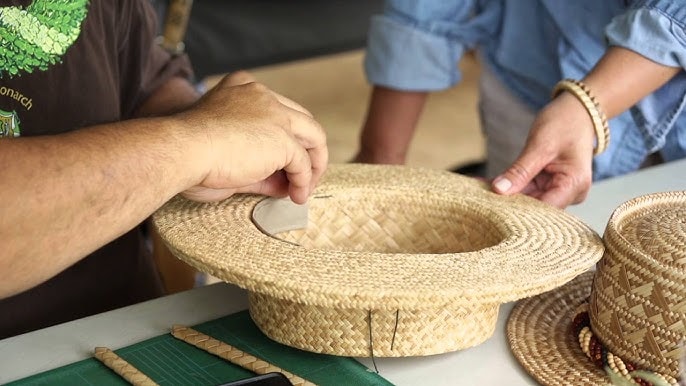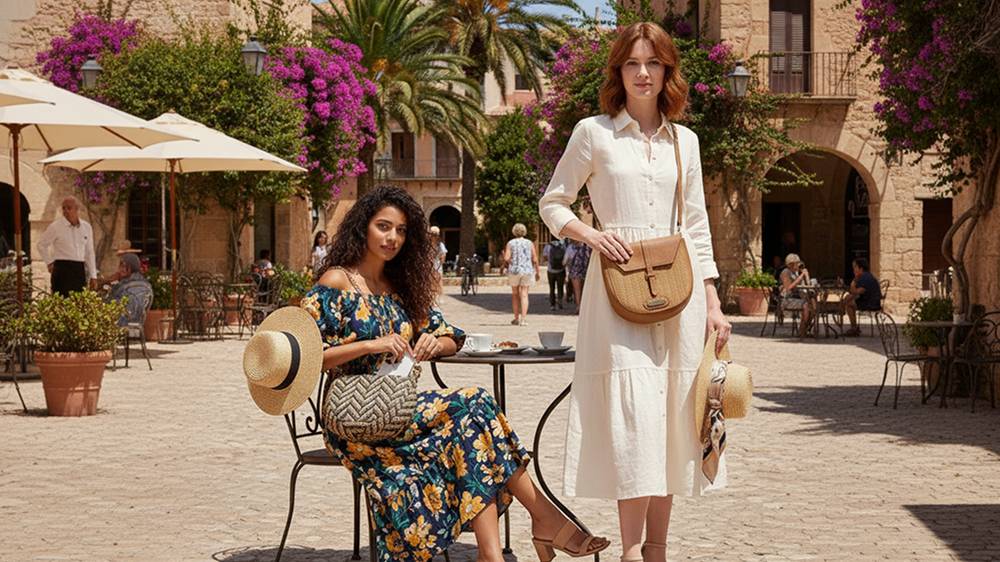Understanding that straw hats environmental impact is essential. As people become more aware of the environment, they want fashion choices that are better for the planet.
Straw hats are a good option because they break down naturally and are often made in a responsible way. They also usually have a smaller environmental impact than synthetic hats.
With eco-friendly fashion becoming more popular, people are searching for items that look good and show they care about the environment that's why many popular brands are making sustainable hats.
In this trend, straw hats are a step forward in choosing fashion that is better for the planet.
Understanding Straw Hat Environmental Impact
Straw hats are made from different eco friendly materials, each with unique qualities.
Here are some common ones:
-
Raffia: Strong and flexible, great for detailed designs.
-
Wheat Straw: Light and airy, ideal for hot weather.
-
Seagrass: Gives a rustic look and resists water.
Consequently, these environmental materials play a significant role in creating different women styles and designs of straw hats.
In particular, some popular styles include:
-
Panama Hats: Classic style for both casual and formal outfits.
-
Boater Hats: Flat top and brim, often seen in vintage fashion.
-
Wide-Brimmed Hats: Best for maximum sun protection.
Beyond their visual appeal, straw hats also offer practical benefits:
-
Sun Protection: The wide brims shield the face and neck from harmful UV rays.
-
Breathability: Natural fibers allow air circulation, keeping the head cool.
-
Lightweight: These hats are easy to wear for extended periods without causing discomfort.
Overall, by understanding these aspects, we can better appreciate the versatility and usefulness of straw hats.
Environmental Benefits of Straw Hats
Biodegradable Nature of Straw Hats
Straw hats are crafted from natural materials like raffia, wheat straw, and seagrass, which makes them highly biodegradable and eco-friendly.
Specifically, these materials break down naturally over time, returning to the earth without leaving harmful residues or contributing to textile waste.
In contrast, this is a significant advantage over synthetic materials, which can persist in the environment for years, leading to increased environmental impact and emissions.
Opting for biodegradable products helps protect biodiversity and reduce fossil fuels. This choice not only supports local artisans and communities but also aligns with a commitment to alter supply chains and invest in more sustainable practices.
Low Environmental Footprint
Compared to synthetic hats made from plastics or other non-renewable resources, straw hat have a low environmental impact. In particular, the production process requires minimal energy and water, thereby reducing the overall carbon footprint and energy use.
Moreover, the absence of toxic chemicals and synthetic materials in the manufacturing process further ensures that these hats do not contribute to pollution.

This eco-friendly approach aligns with global efforts to combat climate change, reduce emissions, and protect vital natural resources.
By choosing biodegradable options and investing in sustainable practices, companies can support local artisans and contribute to a more transparent and responsible business model.
Ethical Sourcing Practices
Ethical sourcing is a cornerstone of the straw hat industry. Specifically, many producers prioritize sustainably harvested materials, which ensures that their cultivation does not harm local ecosystems.
For example:
-
Raffia is often sourced from Madagascar, where sustainable harvesting practices are employed.
-
Wheat straw is a byproduct of wheat farming, making its use in hat production an excellent example of resource efficiency.
-
Seagrass is collected in ways that do not disrupt marine life.
By supporting ethical sourcing practices, consumers can feel confident that their fashion choices align with environmental sustainability.
Sustainable Materials in Hat Production
Innovative materials are changing the game in hat production, with a strong focus on sustainability.
In particular, let's explore some of the key materials making a difference:
1. Organic Cotton
Organic cotton is an eco friendly fabric that is grown without synthetic chemicals or pesticides, which makes it gentler on the environment.
Furthermore, it helps reduce water contamination, thus making it a more sustainable choice for hat production.
2. Bamboo
Bamboo is known for its rapid growth and minimal need for water. As a result, this makes it an eco-friendly choice that requires fewer resources compared to traditional crops.
Plus, hats made from bamboo are not only stylish but also environmentally friendly.
3. Hemp
Hemp is a resilient plant that grows quickly, needs little water, and thrives without pesticides. Consequently, its fibers are strong and durable, making them ideal for long-lasting hats.
By using hemp in hat production, we can support sustainable farming practices.
4. Piñatex
Piñatex is derived from pineapple leaves and serves as a sustainable alternative to leather. In addition, it utilizes agricultural waste, reducing landfill burden and providing additional income to farmers.
Therefore, hats made from Piñatex offer a cruelty-free option for fashion-conscious individuals.
These materials not only have unique qualities but also offer distinct environmental benefits:
-
Organic cotton avoids harmful chemicals.
-
Bamboo minimizes water usage.
-
Hemp supports soil health.
-
Piñatex upcycles waste.
By incorporating these sustainable materials into hat production, we can significantly reduce the use of harmful chemicals and conserve precious water resources.
This aligns perfectly with the growing trend of eco-conscious fashion, where consumers are actively seeking out products that have a positive impact on the planet.
Crafting Process and Sustainability Practices in Straw Hat Production
The crafting process of straw hats involves several meticulous steps, all aimed at producing high-quality and eco-friendly accessories.
Initially, local artisans select the raw materials, such as raffia, wheat straw, or seagrass, ensuring they are sustainable and biodegradable.

Subsequently, these natural resources are cleaned and dried to prepare them for weaving.
Once ready, the weaving process often involves handcrafting techniques passed down through generations, highlighting the importance of skill, tradition, and the reduced energy demand in creating each hat.
This artisanal approach not only supports local communities but also reduces the reliance on synthetic materials and minimizes textile waste, reflecting a commitment to sustainable production practices and a transparent supply chain.
Brands focusing on sustainably sourced materials play a crucial role in promoting eco-friendly fashion.
For instance:
-
Tenth Street Hats emphasizes using organic and biodegradable materials in their production cycle.
-
Gigi Pip sources its materials from ethical suppliers, ensuring minimal environmental impact.
Emerging practices, such as upcycling fabric, are gaining traction in the industry. In particular, upcycling involves repurposing discarded textiles to create new products, thereby minimizing waste and reducing the need for virgin materials.
For more information about upcycled materials read our blog post
From Waste to Wardrobe: Upcycled Straw Hats
This practice not only helps in recycling but also addresses the increased demand for sustainable solutions.
For example, brands like Will & Bear are leading this movement by incorporating upcycled fabrics into their designs, creating unique and sustainable straw hats that reflect a commitment to protecting natural resources.
Overall, these sustainability practices not only benefit the environment by mitigating climate change and reducing emissions but also add a layer of authenticity and factor to each straw hat produced.
By supporting these innovative approaches, consumers can feel good about their choices and contribute to a more sustainable world.
Caring for Straw Hats Sustainably: Tips for Eco-Conscious Fashion Lovers

Maintaining the quality and longevity of straw hats involves adopting eco-conscious practices.
Here are some maintenance tips to ensure your hat remains in excellent condition:
Best Practices for Longevity
-
Keep Dry: Moisture can weaken straw fibers. Always store your hat in a dry place.
-
Avoid Crushing: Place your hat on a flat surface or use a hat stand to maintain its shape.
-
Handle with Care: Use clean hands to avoid transferring oils and dirt.
Eco-Friendly Cleaning Methods
-
Spot Cleaning: Use a damp cloth with mild soap to gently clean spots. Avoid soaking the entire hat.
-
Natural Brushes: Employ soft-bristled brushes made from natural materials for regular dusting.
-
Sunlight: Occasionally air out your hat in natural sunlight to eliminate odors, but avoid prolonged exposure that could cause fading.
Storage Solutions
-
Hat Boxes: Store your hats in breathable hat boxes (check our Productbox-XL) to prevent dust accumulation.
-
Dark Places: Keep your hats away from direct sunlight and heat sources.
Proper care significantly extends the life cycle of fashion accessories like straw hats. By incorporating these eco-friendly practices, you not only maintain the aesthetics of your hat but also contribute to sustainable fashion.
Consumer Trends Towards Eco-Friendly Fashion Choices including Straw Hats
Rise in Demand for Sustainable Fashion Choices Among Consumers
Eco-conscious consumers are increasingly seeking sustainable choices in their wardrobes. This shift is driven by a growing awareness of environmental issues and a desire to reduce personal carbon footprints.
Moreover, sustainable fashion choices are now more accessible and trendy, which makes it easier for consumers to make eco-friendly decisions.
How Straw Hats Fit into the Larger Trend of Eco-Conscious Products
Straw hats have become a popular item among eco-conscious consumers due to their low environmental impact. In particular, they align with the principles of sustainable fashion by using natural, biodegradable materials and ethical sourcing practices, which helps reduce textile waste and the reliance on fossil fuels.
As a result, straw hats are not just a stylish accessory but also a responsible choice for those looking to support environmentally friendly products. Their use of eco-friendly fabrics and commitment to transparent supply chains reflect a broader movement towards sustainability.
Furthermore, their versatility in design and function, from bucket hats to wide-brimmed styles, enhances their appeal in the sustainable fashion market.
By choosing straw hats, consumers not only invest in a unique accessory but also contribute to reducing their personal carbon footprints and supporting local artisans and sustainable practices.
Summary
Straw hats represent an outstanding example of sustainable fashion, offering significant environmental benefits through their use of biodegradable materials like raffia, wheat straw, and seagrass that break down naturally without contributing to textile waste.
Their production process requires minimal energy and water while supporting ethical sourcing practices and local artisans, resulting in a dramatically lower carbon footprint compared to synthetic alternatives.
The versatility of straw hats extends beyond their eco-friendly nature, providing practical benefits such as UV protection, breathability, and lightweight comfort in various styles from classic Panama hats to wide-brimmed designs.
By choosing straw hats, consumers can embrace both style and sustainability while actively contributing to environmental protection and supporting responsible fashion practices.
Ready to make a positive environmental impact with your fashion choices?
Explore our sustainable straw hat collection today and discover stylish, eco-friendly accessories that align with your values while protecting the planet. Shop online!
FAQs
Are straw hats environmentally friendly compared to synthetic alternatives?
Yes, straw hats have a much lower environmental impact than synthetic alternatives. They're made from renewable materials like wheat straw and seagrass that require minimal energy to produce. Unlike plastic hats, straw hats are completely biodegradable and won't persist in landfills for centuries.
What types of sustainable materials are used in eco-friendly straw hat production?
Eco-friendly straw hats use renewable natural materials including wheat straw, seagrass, raffia, bamboo, and organic cotton. These fast-growing plants require minimal water and no pesticides. Some manufacturers also use innovative materials like marine seagrass that support coastal ecosystems.
How does the production process of straw hats minimize environmental damage?
Straw hat production uses traditional weaving techniques that consume minimal energy and produce little waste. The cultivation of natural fibers requires less intensive farming than synthetic materials. Many producers support local artisans, reducing transportation emissions, and implement waste reduction strategies throughout their supply chains.
What happens to straw hats at the end of their lifecycle?
Natural straw hats are completely biodegradable and compostable, unlike synthetic hats that contribute to plastic pollution. When disposed of properly, they decompose naturally without releasing harmful chemicals. Many high-quality straw hats can also be repaired to extend their useful life.
How can consumers ensure they're buying truly sustainable straw hats?
Look for brands that transparently share information about their materials and production processes. Choose companies that use traditional craftsmanship and fair trade practices. Support brands offering repair services, warranties, or resale programs. Research whether manufacturers use renewable energy and support environmental conservation projects.
























